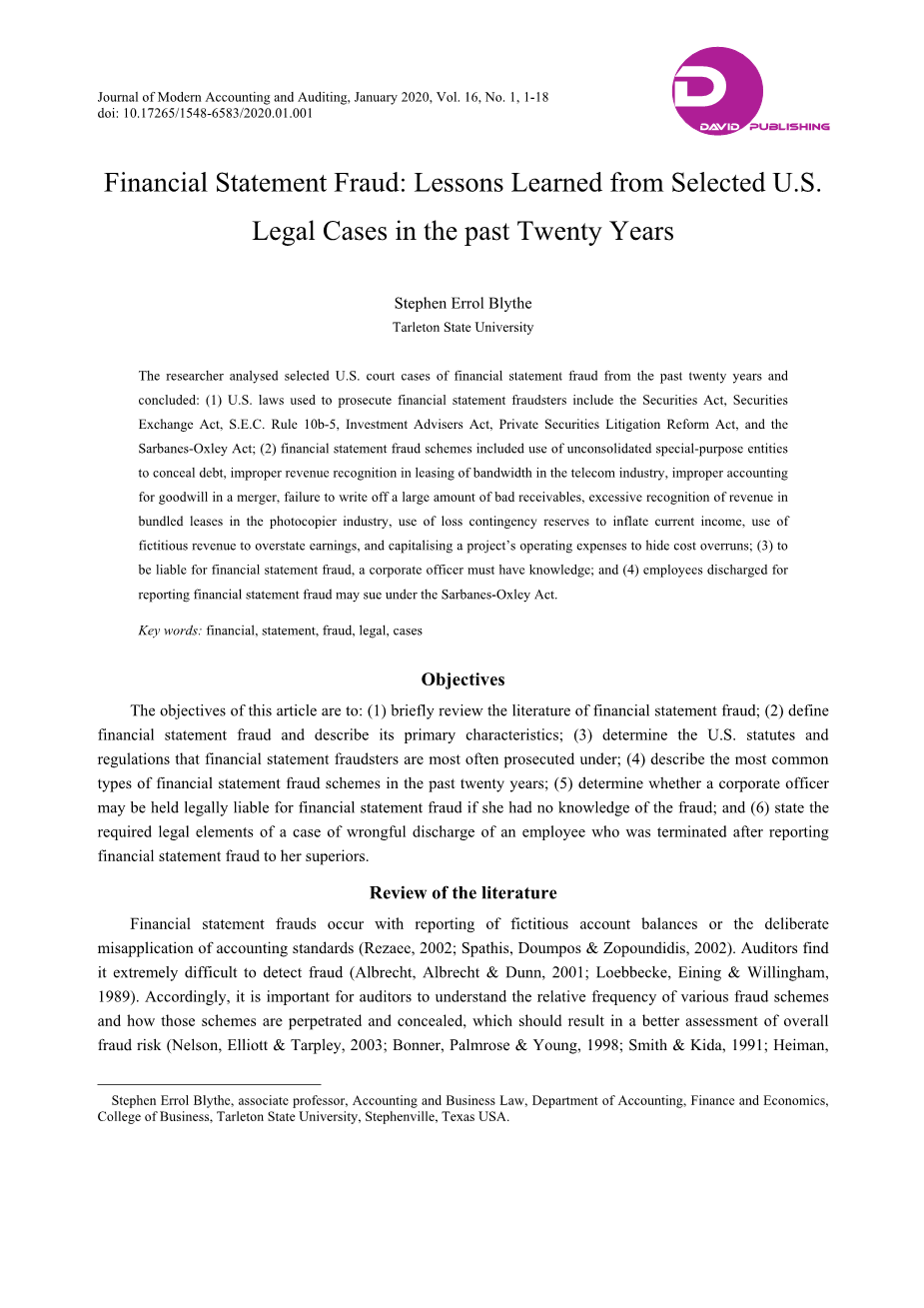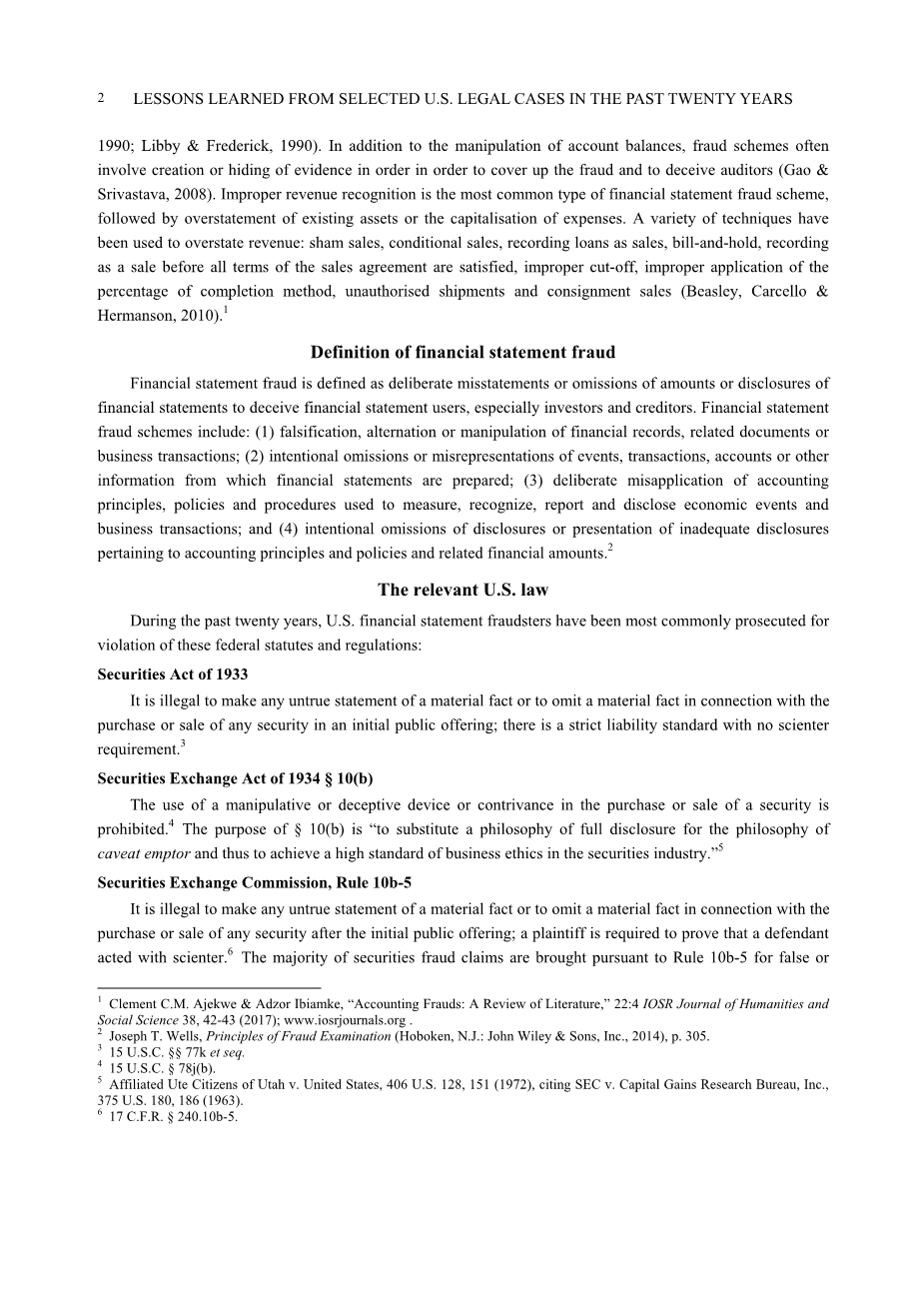

英语原文共 18 页,剩余内容已隐藏,支付完成后下载完整资料
论中国注册会计师的法律责任
外文翻译
Financial Statement Fraud: Lessons Learned from Selected U.S. Legal Cases in the past Twenty Years
Stephen Errol Blythe
Abstract
The researcher analysed selected U.S. court cases of financial statement fraud from the past twenty years and concluded: (1) U.S. laws used to prosecute financial statement fraudsters include the Securities Act, Securities Exchange Act, S.E.C. Rule 10b-5, Investment Advisers Act, Private Securities Litigation Reform Act, and the Sarbanes-Oxley Act; (2) financial statement fraud schemes included use of unconsolidated special-purpose entities to conceal debt, improper revenue recognition in leasing of bandwidth in the telecom industry, improper accounting for goodwill in a merger, failure to write off a large amount of bad receivables, excessive recognition of revenue in bundled leases in the photocopier industry, use of loss contingency reserves to inflate current income, use of fictitious revenue to overstate earnings, and capitalising a projectrsquo;s operating expenses to hide cost overruns; (3) to be liable for financial statement fraud, a corporate officer must have knowledge; and (4) employees discharged for reporting financial statement fraud may sue under the Sarbanes-Oxley Act.
Introduction
The objectives of this article are to: (1) briefly review the literature of financial statement fraud; (2) define financial statement fraud and describe its primary characteristics; (3) determine the U.S. statutes and regulations that financial statement fraudsters are most often prosecuted under; (4) describe the most common types of financial statement fraud schemes in the past twenty years; (5) determine whether a corporate officer may be held legally liable for financial statement fraud if she had no knowledge of the fraud; and (6) state the required legal elements of a case of wrongful discharge of an employee who was terminated after reporting financial statement fraud to her superiors.
Definition of financial statement fraud
Financial statement fraud is defined as deliberate misstatements or omissions of amounts or disclosures of financial statements to deceive financial statement users, especially investors and creditors. Financial statement fraud schemes include: (1) falsification, alternation or manipulation of financial records, related documents or business transactions; (2) intentional omissions or misrepresentations of events, transactions, accounts or other information from which financial statements are prepared; (3) deliberate misapplication of accounting principles, policies and procedures used to measure, recognize, report and disclose economic events and business transactions; and (4) intentional omissions of disclosures or presentation of inadequate disclosures pertaining to accounting principles and policies and related financial amounts.
The legal requirements in pleading a case of financial statement fraud in the United States
Whenever a U.S. plaintiff alleges that a defendant firmrsquo;s financial disclosures were false and misleading due to accounting improprieties, the standard for pleading accounting fraud must be addressed. To properly state a claim for accounting fraud, plaintiffs must plead facts sufficient to support a conclusion that the defendant firm prepared fraudulent financial statements and that the alleged financial fraud was material. Generally Accepted Accounting Principles (GAAP) violations can provide evidence of scienter. However, the complaint must describe the violations with sufficient particularity; a general allegation that the practices at issue resulted in a false report of company earnings is not a sufficiently particular claim of misrepresentation
When pleading irregularities in revenue recognition, plaintiffs should allege: (1) such basic details as the approximate amount by which revenue and net income were overstated; (2) the products involved in the contingent transaction; (3) the dates of any of the transactions; or (4) the identities of any of the customers or the firmrsquo;s employees involved in the transaction.Although a plaintiff need not allege each of these particular details, he must allege enough to allow a court to discern whether the alleged GAAP violations were minor or technical in nature, or whether they constituted widespread and significant inflation of revenue.Thus, to support a claim of fraud, a plaintiff must plead with particularity how the accounting manipulations affected the firmrsquo;s financial statements and whether they were material in view of the firmrsquo;s overall financial position.
Types of financial statement fraud, with cases
1.Enronrsquo;s fraudulent use of special-purpose entities to conceal massive debt and the existence of a Ponzi scheme
Enron Corporationrsquo;s shareholders and holders of debt securities brought a derivative action against Enron. They alleged that Enron violated the Securities Act of 1933, the Securities and Exchange Act of 1934, SEC Rule 10b-5 and the Texas Securities Act.18 During 1998-2001, Enron Corporationrsquo;s senior management fraudulently manipulated Enronrsquo;s publicly reported financial statements. Their purpose was to mislead investors and others about the true financial position of Enron and inflate the price of Enron stock and maintain its credit rating. Four special purpose entities (SPEs) were used to hide massive debt. Those SPEs were purportedly independent of Enron and were ostensibly to be used to hedge the value of certain assets, but in fact they were not sufficiently independent of Enron and should have been included in its consolidated financial statements, instead of being deconsolidated. As a result, Enron dramatically overstated its earnings because a large amount of corporate debt was transferred from Enron
剩余内容已隐藏,支付完成后下载完整资料
资料编号:[234215],资料为PDF文档或Word文档,PDF文档可免费转换为Word
课题毕业论文、开题报告、任务书、外文翻译、程序设计、图纸设计等资料可联系客服协助查找。
您可能感兴趣的文章
- 饮用水微生物群:一个全面的时空研究,以监测巴黎供水系统的水质外文翻译资料
- 步进电机控制和摩擦模型对复杂机械系统精确定位的影响外文翻译资料
- 具有温湿度控制的开式阴极PEM燃料电池性能的提升外文翻译资料
- 警报定时系统对驾驶员行为的影响:调查驾驶员信任的差异以及根据警报定时对警报的响应外文翻译资料
- 门禁系统的零知识认证解决方案外文翻译资料
- 车辆废气及室外环境中悬浮微粒中有机磷的含量—-个案研究外文翻译资料
- ZigBee协议对城市风力涡轮机的无线监控: 支持应用软件和传感器模块外文翻译资料
- ZigBee系统在医疗保健中提供位置信息和传感器数据传输的方案外文翻译资料
- 基于PLC的模糊控制器在污水处理系统中的应用外文翻译资料
- 光伏并联最大功率点跟踪系统独立应用程序外文翻译资料



